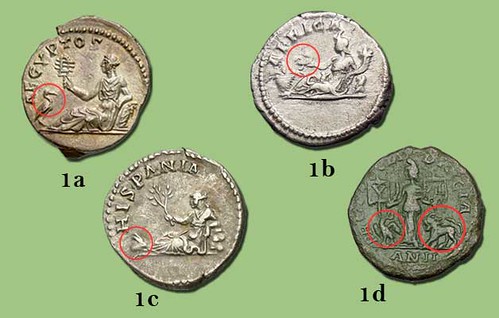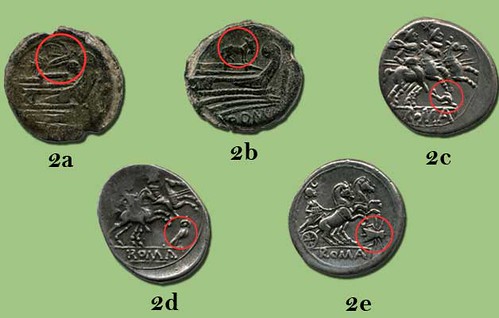
PREV ARTICLE
NEXT ARTICLE
FULL ISSUE
PREV FULL ISSUE
ANIMALS ON ANCIENT COINS: PROVINCES AND MONEYERSIndia's Mintage World recently published a two-part article about animals on Roman coins. Here is an excerpt from the second part, published March 20, 2018, covering two interesting aspects:
animals representing the province and animals representing the moneyer. -Editor
Animals associated with the province  The first coin (1a) depicts Aegyptos, Egypt personified as a woman seated on the ground with Ibis, near her leg, depicted facing the goddess. This reverse design of this coin was common in all the coins of Emperor Hadrian. These coins were stuck on the occasion of the Emperor’s visit to Egypt. The Ibis was sacred and peculiar to Egypt. It is said that this bird would die if taken somewhere else. Ibis was worshipped, due to its nature to destroy the serpent and insects that destroy the food supply. The province of Africa, a northern part of the vast continent under the administration of Rome extended to the shores of the Mediterranean Sea. The personification of this province on the coin was same as Aegyptos, her headgear was in the shape of elephant’s trunk. Africa holds a scorpion in her right hand on the above-shown coin (1b). This coin was struck under Emperor Hadrian on his journey to the Province of Africa. The symbol of the scorpion is seen as a rich natural resource of this province. The Scorpion is also recognized as the goddess Africa third venomous animal. The silver denarius (1c) depicts the personification of the province Hispania near her feet a rabbit. The significance of the hare on this coin was that this animal was found in abundance in Spain. Emperor Hadrian depicted Hispania on the silver, gold and bronze issues during his visit to Spain province. Later on, the same design was copied by Emperor Ulpius Cornelius Laelianus on his gold aureus in 269 CE. The coin showed in the image 1d is interesting: the personification of the Dacia province in the form of a woman is illustrated in the centre with the eagle and lion depicted near her leg. The animals shown on this coin represent the Roman legions (army units). Lion is the symbol of Legio XIII Gemina and eagle represents Legio V Macedonica legion. This coin was issued to pay homage to the Roman legions garrisoned in the province during Emperor Philip of the Arabs reign. Other interesting coins presenting goddess and animals are Mauretania with the horse, Africa with the lion, Arabia with camel and Moesia with bull and lion, etc. Animals as moneyers (Mint masters) initials The coinage of Roman Republic was issued by the authority of the Roman senate. The denarius series of this monetary system had different variations, in this series different types of anagram, monogram and small animal symbols came up, this kind of coins circulated till 150 BCE. These symbols were the initials of moneyer ’s, the mint master in the Roman Republic, three mint masters issued coins  The bronze As depicted in the above image (2a) features a butterfly resting on a vine branch with leaves and grapes around it. In Roman culture, the butterfly represents liberation after the death because of their life cycle. The soul is also called butterfly-soul which gets liberated from a cocoon of the body after death. The significance of butterfly in this coin is unknown, it may be the initials of a moneyer. A donkey is depicted on the bronze as (2b) standing above the ship Prow. The donkey was an important domestic animal for the common citizens of Rome. On this coin, it may be connected to the moneyer’s origin from his lower class. The dolphin is depicted on the Roman coin in a fixed position or in a state of motion. Dolphin in important to Neptune the god of the sea, it was also associated with goddess Venus and God Apollo. On this denarius (2c) of the republic, the dolphin is depicted below the Dioscuri. This may be connected to a moneyer, but the significance of these initials is still unclear. The fourth coin in the image, silver denarii (2d) depicts an owl below the deity Dioscuri( twin sons of Zeus). The owl is the companion of Minerva, the goddess of wisdom and strategies. Romans believed that the presence of a hooting owl on the roof brings the news of death. Owl was also the embellishment of knowledge and intelligence. The last animal in this category is a fly, It is depicted at the bottom of the Biga driven by Goddess Luna on the last coin (2e). This insect may have a symbolic importance in the Roman culture. It has some connection to the epidemic-prone area, but any documented proof is not present. This symbol mostly appears on the coin in the anonymous denarius coinage of the Republic. To read the complete article, see: To read the earlier installment, see:  Wayne Homren, Editor The Numismatic Bibliomania Society is a non-profit organization promoting numismatic literature. See our web site at coinbooks.org. To submit items for publication in The E-Sylum, write to the Editor at this address: whomren@gmail.com To subscribe go to: https://my.binhost.com/lists/listinfo/esylum All Rights Reserved. NBS Home Page Contact the NBS webmaster 
|